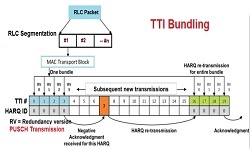Amplifier Efficiency Concept, How Envelope Tracking (ET) helps better efficiency to Power Amplifiers?
Envelope tracking (ET) describes an approach to radio frequency (RF) amplifier design in which the power supply voltage applied to the RF power amplifier is continuously adjusted to ensure that the amplifier is operating at peak efficiency for power required at each instant of transmission.
Power Amplifier Efficiency Curve
A conventional RF amplifier designed with a fixed supply voltage operates most efficiently only when operating in compression.
Power amplifier output power vs efficiency curve shows that higher the output power of the amplifier, higher will be the efficiency.
 In case of GSM, it is based on a constant envelope modulation, which means that PAPR of that signal is close to zero. So the output power of GSM amplifier is close to saturation point, so it has better efficiency as shown below:
In case of GSM, it is based on a constant envelope modulation, which means that PAPR of that signal is close to zero. So the output power of GSM amplifier is close to saturation point, so it has better efficiency as shown below:
And how the GSM constant envelope signal looks like in time domain:
In case of LTE signal, due to OFDM modulation, the PAPR is close to 12dB. And using some baseband techniques, 8.5dB PAPR is achieved. Hence, due to this 8.5dB PAPR, the power amplifier operates 8.5dB below the saturation point and which causes the drop in PA efficiency, as shown below:
And how the LTE varying envelope signal looks like in time domain:
If the peak to average power ratio is high, i.e. the waveform has higher peak levels when compared to the average because the amplifier has to be able to accommodate the peaks while still only running at a low average power level.
During the peaks, the amplifier requires the full supply voltage to be able to deliver the required power without running into compression, but during the periods of lower signal, this voltage is not required and means that power is dissipated in the device. The amplifier only requires a smaller voltage to deliver the lower levels of power and therefore running with the higher voltage all the time, unnecessarily wastes power.
It can be seen that the power dissipated is proportional to the area between the top of the RF envelope and the rail voltage. For low peak to average power ratio signals, this can be high.
Envelope tracking: basic concept
In order to improve the efficiency levels of RF amplifiers, one of the approaches that can be used is to employ envelope tracking technology.
As the name indicates, envelope tracking employs a system whereby the amplitude envelope of the signal is tracked and utilized by the amplifier.
Using envelope tracking the power supply voltage applied to the power amplifier is constantly adjusted to ensure that the amplifier is operating at peak efficiency for the given instantaneous output power requirements.
An envelope tracking systems will take the envelope appearing at the input of the power amplifier and then use this to drive the power supply providing the line voltage for the RF power amplifier. This is modulated to ensure that it correctly tracks the amplitude of the signal.
ET Technology Progress
In 2013, Qualcomm became the first company to ship a chip with such technology, which it claimed to be the industry’s first for 3G and 4G LTE mobile devices. R2 Semiconductor became the industry’s first ET company to ship a phone with ET in the Samsung Galaxy S5 Mini.
As of September 2014, at least 16 phones employ ET, including the Samsung Galaxy Note 3, Galaxy S5 Mini, Nexus 5, and iPhone 6. Other component makers evaluating the technology include R2 Semiconductor, Mediatek, RF Micro Devices, Skyworks, Texas Instruments, Analog Devices, Nujira and Eta Devices.
Eta Devices, an MIT spinoff based in Cambridge, Massachusetts, is preparing a base station module and a chip that it claims decreases battery drain and work well in high-bandwidth applications. The company says the chip helps lower electricity consumption by 20 percent and helps reduce heat generation by up to 30 percent. Eta’s approach increases efficiency at the cost of greater signal noise. The company uses advanced digital signal processing to handle the problem. The Eta basestation is a little smaller than a shoebox, is the first 4G LTE transmitter to achieve average efficiency greater than 70 percent, up from the typical 45 to 55 percent.









